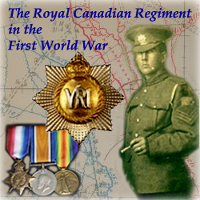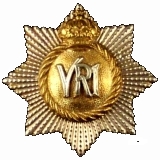
The First World War
War Diary of The Royal Canadian Regiment
Transcription by Captain Michael O'Leary, The RCR.
JANUARY 1917
APPENDIX 2.
THE ROYAL CANADIAN REGIMENT
SA 274
7TH Canadian Infantry Brigade
The following is a summary of the raid carried out in accordance with my Operation order No. 1, dated 22d January, 1917.
At the ZERO hour the party entered the Enemy's trenches and met with no opposition.
(a) Party "A" Lieut. GRAY, Sgt. ORR
Dealt with Two Dugouts, both full. Numerous Mills Bombs and Smoke Bombs were used in both cases. Estimated German casualties Fifteen; dead actually seen Five. Two Prisoners taken. A Party of Four of the Enemy showed fight. One was killed; the other three immediately started to run. They were dealt with by the Bombers. Nine of the Enemy coming out of a dugout tried to break up out party by bombs. They were bombed in turn and all Nine killed.
(b) Party "B" Lieut. ROOKS
Dealt with Nine Dugouts, all full. Numerous Mills Bombs and Smoke Bombs were used on all of them. Estimated German casualties Thirty-six; dead actually seen, Four. Two prisoners taken. Sentry on duty offered resistance. He was quickly despatched and his two reliefs surrendered.
(c) Party "C" Sergt. ROSS
Dealt with Four Dugouts, all full. Numerous Mills bombs used in each case. Estimated German casualties Thirty-five; dead actually seen, Three. One prisoner. Party of Three men in entrance of Dugout resisted. Two of them were killed, one prisoner.
At 7.45 a.m. Lieut. GRAY sounded the Bugle for all parties to withdraw. This was heard by Party "C" and "A" only.
Lieut. ROOKS had reached his objective and was proceeding back to re-bomb dugout when his party saw our signal rocket which was fired at 7.50 a.m. he at once withdrew.
All parties were clear a few minutes after this and did not meet with any opposition returning. Rifle Grenadiers covered each party.
Only one Sentry Post was found in the whole of the raided area. This was in the Enemy's Front Line just to the Left rear of WATLING CRATER. It was a bay about 15 feet long with a Firing Step in the centre approximately a yard long, nery narrow and poorly put up. At one end of it there was a small corrugated iron shelter in which the Sentry who offered resistance was sitting apparently taking cover from the bombardment. The Sentry's reliefs were in a dugout close at hand. Their rifles, in a very dirty condition were leaning against the side of the trench. The Sentry was not wearing his Gas helmet. Only one man was seen by any one to be wearing a Gas helmet.
WATLING CRATER Post was practically non-existent having been almost obliterated by our Artillery and trench Mortars. From what could be seen of it, it was very much like our own Crater Posts, i.e. A Sap leading up to a small piece of raised ground, lightly sandbagged for protection from splinters.
None of the raiding party were any further than half way down the steps of a dugout. Every dugout had a Gas Blanket about three steps from the entrance. Entrances which existed, were all in good condition. One especially was noticed by Lieut. ROOK's party for its width and height. It also had what appeared to be a rain cover over the entrance extending out about Two feet.
There were no Flying Traverses whatsoever in the trenches raided. From the sounds heard, the dugouts appeared to be about Thirty feet deep, most of them having two entrances from twenty to Thirty feet apart. One or two had three entrances and some had only one. Rifles, Steel helmets, and gas helmets were placed promiscuously just inside the entrances to dugouts or in trenches in the neighbourhood of the dugouts.
Trenches practically cease to exist owing to the excellent work of our Artillery and Trench Mortars. At one time they had been revetted and Bath-matted. It seemed that the Enemy had devoted his whole attention to the dugouts letting the trenches go. No emplacements of any kind were seen in the trenches. Enemy wire was in most places good but there were a number of gaps on the front raided.
The raid was apparently a complete surprise. It is thought that the Germans were caught at their breakfast hour.
The co-operation of the Artillery was excellent, including 2" and Stokes.
All parties reached their objectives and the entire operation worked without a hitch.
There was no retaliation from the Enemy except a few trench Mortars fired into WATLING CRATER and their own front line after we had withdrawn.
From the tracing of the Aeroplane map, scale 1/2500 we were led to believe that the majority of the dugouts were on our left of Watling Crater whereas it was found that nearly all dugouts were on our right.
Our casualties were three wounded, one severely. The severely wounded man was carried out by one of the bombers, the other two wounded walked out. Casualties were caused by Enemy Bombs.
(initialled)
C.R.E.W.
Major.
Commanding The Royal Canadian Regiment.
25-1-17
- The O'Leary Collection; Medals of The Royal Canadian Regiment.
- Researching Canadian Soldiers of the First World War
- Researching The Royal Canadian Regiment
- The RCR in the First World War
- Badges of The RCR
- The Senior Subaltern
- The Minute Book (blog)
- Rogue Papers
- Tactical Primers
- The Regimental Library
- Battle Honours
- Perpetuation of the CEF
- A Miscellany
- Quotes
- The Frontenac Times
- Site Map

![]() The RCR in the Great War
The RCR in the Great War
![]() War Diary
War Diary
![]() Battle Honours
Battle Honours
![]() Battle Bars and The RCR
Battle Bars and The RCR
![]() The RCR Battle Bar Ledger (pdf)
The RCR Battle Bar Ledger (pdf)
![]() Honours and Awards
Honours and Awards
![]() Roll of Honour
Roll of Honour
![]() Prisoners of War
Prisoners of War
![]() Cemetery List
Cemetery List
![]() Cemetery Map
Cemetery Map
![]() Courts Martial
Courts Martial
![]() Officers
Officers
![]() RSMs of The RCR (1914-1919)
RSMs of The RCR (1914-1919)
![]() NCOs and Soldiers
NCOs and Soldiers
![]() An Officer's Diary (1914-1918)
An Officer's Diary (1914-1918)
![]() Recollections of a Nonagenerian (R. England) (1916-1919)
Recollections of a Nonagenerian (R. England) (1916-1919)
![]() On to Bermuda (1914-15)
On to Bermuda (1914-15)
![]() England and France 1915-1916 (Hayes; 1931)
England and France 1915-1916 (Hayes; 1931)
![]() Overseas with The Royals (1915)
Overseas with The Royals (1915)
![]() Regimental History Pamphlet (1917)
Regimental History Pamphlet (1917)
![]() Amiens (1918)
Amiens (1918)
![]() Cambrai (1918)
Cambrai (1918)
![]() Monchy-le-Preux (1918)
Monchy-le-Preux (1918)
![]() Under-aged Soldiers in The RCR
Under-aged Soldiers in The RCR
![]() Not All Were Volunteers; The RCR and the Military Service Act
Not All Were Volunteers; The RCR and the Military Service Act
![]() Sentenced to Death by Court Martial
Sentenced to Death by Court Martial
![]() The 7th Trench Mortar Battery
The 7th Trench Mortar Battery
![]() A Regimental Goat
A Regimental Goat
![]() Regiment and Family, Bermuda 1914-15
Regiment and Family, Bermuda 1914-15
![]() "March the Guilty Bastard In"
"March the Guilty Bastard In"
![]() Surrendered as Stowaway
Surrendered as Stowaway
![]() Re-Visiting the Great War Roll of Honour for The RCR
Re-Visiting the Great War Roll of Honour for The RCR
![]() Canadian Corps Trench Standing Orders (1916)
Canadian Corps Trench Standing Orders (1916)

